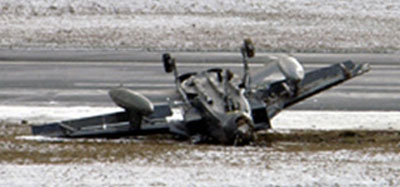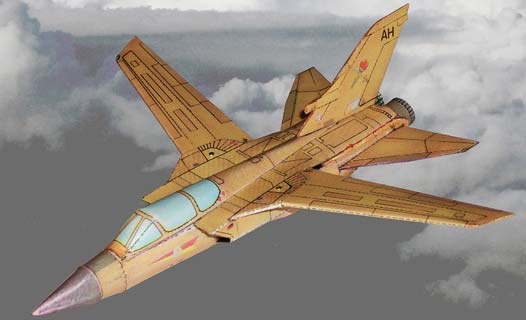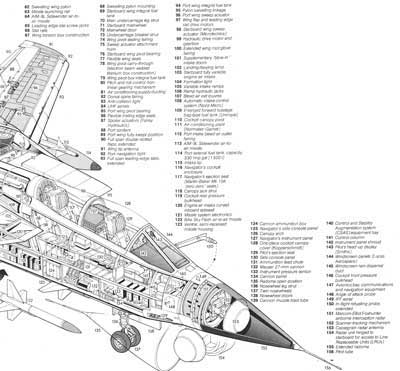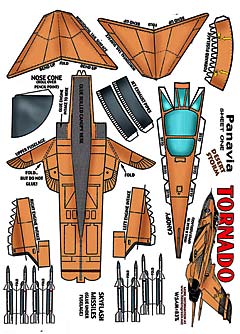
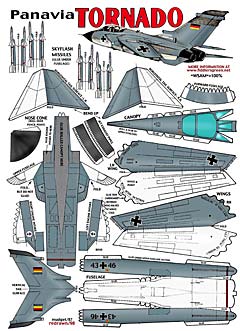
Tornado - $$3.95
The Panavia Tornado is a family of twin-engine combat aircraft. There are three primary versions of the Tornado IDS (Interdictor/Strike) fighter-bomber, the suppression of enemy air defences Tornado ECR (Electronic Combat/ Reconnaissance) and the Tornado ADV (Air Defence Variant) interceptor.
The swept wing Panavia Tornado

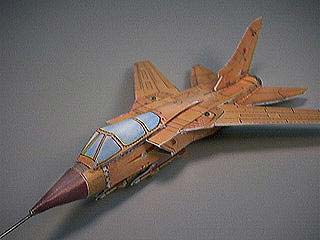
Panavia Tornado model is in desert storm colors and has variable swept wings which make the building of this little beauty just a bit more complicated...but well worth the little extra effort.
When the Federal Republic of Germany, Italy and Great Britain joined forces to design and build a multi-role combat aircraft, few observers believed that it could be anything but a disaster.
It is, after all, not uncommon for large aircraft corporations in one country to have problems in pursuing a single strategy.
Panavia Tornado
Combined Forces
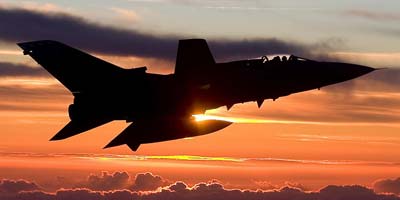 When the Federal Republic of Germany, Italy and Great Britain
joined forces to design and build a multi-role combat aircraft,
few observers believed that it could be anything but a disaster.
It is, after all, not uncommon for large aircraft corporations
in one country to have problems in pursuing a single strategy.
When the Federal Republic of Germany, Italy and Great Britain
joined forces to design and build a multi-role combat aircraft,
few observers believed that it could be anything but a disaster.
It is, after all, not uncommon for large aircraft corporations
in one country to have problems in pursuing a single strategy.
So how could not one, but three different nations combine to produce the total harmony necessary for such a complex project? That they succeeded is amply demonstrated by the result of their collaboration: the Panavia Tornado IDS is certainly the best low-level strike aircraft ever built. Like all modern aircraft, the Tornado is the response to a need.
In this case four separate needs from three Countries: the British Royal Air Force, the Italian Air Force, the German Luftwaffe and the German Marineflieger (naval air arm). The builders of the Tornado had to clear a vast range of weapons for these four initial customers, probably a greater variety of weapons than any other aircraft in history.
In 1969 the three countries began a series of discussions to determine whether they could collaborate to build a single aircraft that would deliver these weapons in the most cost effective way possible. Critics will point Out that it took four years to produce a baseline requirement, but from then on events moved swiftly.
The original specification. agreed in March 1969, called for an MRCA (Multi-Role Combat Aircraft) that would deliver for the RAF a two-seat all-weather attack aircraft:
for the Luftwaffe, a multi-role single-seater; for the Marineflieger,
an anti-ship aircraft; and for the Aeronautica Militare Italiano,
a single-seat fighter. There were many other variations, but without
the slightest pressure being brought to bear by any of the partners,
all were resolved and a standard aircraft agreed by all customers,
with two seats and integral-tank wings.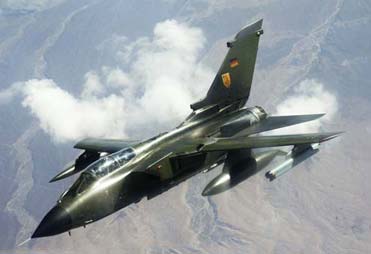
Panavia was established to build the new aircraft, with British Aerospace and West Germany's MBB taking an equal 42.5 per cent stake and with Italy's Aeritalia holding 15 per cent, At the same time a separate engine company, Turbo-Union, was set up to produce the engine, RollsRoyce and MTU holding 40 per cent each, with Fiat taking the remaining 20 per cent.
On 14 August1974, the first Tornado prototype made its first flight at Manching in Germany. From the very start it had used the swing-wing configuration, to match the aircraft to very contrasting conditions. Otherwise the aeroplane was conventional in appearance, with twin engines of amazing compactness.
February 1978 saw the first production Tornado delivered for service tests. Within 18 months, nine prototypes and six production aircraft were all flying for the participating countries. In July I 980 two aircraft were delivered to a special Tn-national Tornado Training Establishment which was set up at RAF Cottesmore in England.
At Cottesmore, pilots and navigators receive basic conversion training on the 50 Tornados stationed there and supplied by the three participating nations. Pilots and navigators of all participating nations are mixed up and fly together.
The Tornado is a true multi-role aircraft. Indeed its flexibility of mission is its chief claim to be the most outstanding aircraft of the decade. But it scores heavily in two other areas as well. In its all-weather long-range low-level attack role, the Tornado is without question, supreme.
No other aircraft can be flown hands-off at supersonic speed at low altitude, hugging the contours of the ground at 200ft or less, sensing and avoiding all obstacles including pylons and radio masts over long ranges, and then reach and destroy a heavily defended target and return to safety.
All this can be done with minimal attention from the pilot. In fact, one pilot was heard to say soon after his conversion at Cottesmore, The navigator flies the ruddy thing, I have nothing to do with it'. Not quite true, but an accurate reflection of the Tornado's astounding low-level performance nonetheless.
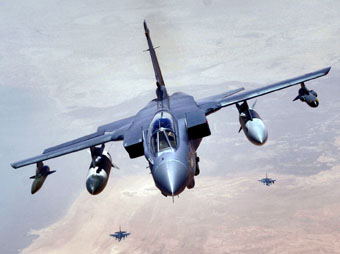 All its life Tornado has been the butt of critics not only
from rivals in France, and especially, the USA, but also in the
home media who eagerly sought supposed faults or shortcomings,
Critics were at last silenced when two PAF aircraft entered the
USAF Giant Voice navigation and bombing contest in 1984. Against
the crack crews of USAF B-S2s and FB- Ills and RAAF F-Ills they
took two of the three main trophies and came second in the third.
Suddenly air forces realized that the Tornado is a world-beater.
All its life Tornado has been the butt of critics not only
from rivals in France, and especially, the USA, but also in the
home media who eagerly sought supposed faults or shortcomings,
Critics were at last silenced when two PAF aircraft entered the
USAF Giant Voice navigation and bombing contest in 1984. Against
the crack crews of USAF B-S2s and FB- Ills and RAAF F-Ills they
took two of the three main trophies and came second in the third.
Suddenly air forces realized that the Tornado is a world-beater.
Avionics are, of course, the key to the Tornado's success. They include a Texas Instruments multi-mode forward-looking radar with fully programmable software, terrain-following radar (of course!), fly-by-wire flight controls and plenty of capacity for special mission avionics, Options include a neat bolt-on retractable inflight-refuelling probe mounted just below the canopy at the right side, so far used only by the RAF, and extremely comprehensive radar warning systems and electronic countermeasures, All the initial users fit jammer and chaff pods on the Outer wing pylons, several types being available.
Internal armament comprises two German Mauser 27mm cannon, housed low in the nose. Seven pylons, with multiple triple ejector racks, can carry an external load of more than 18,0001b. Unlike the F- III, which has to carry all its bombs under the wings, the Tornado can carry over five tons of bombs whilst leaving its wings completely free for drop tanks, jammer/chaff pods and other stores.
Missile loads can include Sea Eagle, Kormoran, Maverick, Alarm, GBU- 15, Paveway, AS. 30, and L. 755 cluster bombs, and the giant JP. 233 and MW. I dispenser systems, and Sidewinder self-defence missiles.
Currently the principal interdictor/strike (IDS) aircraft of three major NATO powers, the swing-wing Tornado was known until 1976 as the MRCA (multi-role combat aircraft). It is produced by a British/German/Italian consortium called Panavia, formed for the purpose seven years earlier, whose industrial members are British Aerospace, MEB (Germany) and Aeritalia.
A parallel consortium of Rolls-Royce, MTU and Fiat, known as Turbo-Union, produces the engines. Design was finalized in 1972, and the development program Involved nine prototypes (first flight 14 August 1974) and six pre series Tornados.
Four of the latter will eventually be upgraded to form part of the eight hundred and nine production aircraft being built for the three member nations. More than five hundred of these had been delivered by the end of 1985, by which time export orders had been placed by Saudi Arabia (forty-eight IDS Tornados and twenty-four of the air defense variant or Any) and Oman (eight Afl Vs). Among the original customers, Britain's Royal Air Force win have two hundred and twenty IDS Tornados (designated GR Mk 1) and one hundred and sixty-five ADV's designated F Mk's 2 and 3.
The Italian Air Force will have a hundred IDS's, while
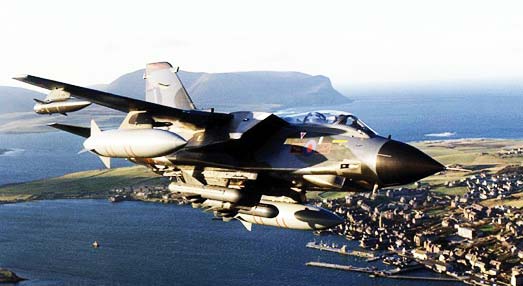 Germany will receive two hundred and twelve for the Luftwaffe
and one hundred and twelve for the Federal German Navy (Bundesmarine).
Germany and Britain each have a 42* per cent share of the production
work, and Italy the other 15 per cent. In the Luftwaffe, the Tornado
is already operational with tour squadrons of Iagdbombergesch
wader 31 and 32, and eventually will completely replace the American
F- 1040 Star fighter for battlefield interdiction, counter-air and close
support duties. Marinefliegergesch wader 1, with two squadrons
operational by 1986, is tasked with carrying Out strike missions
against sea and coastal targets, and with a reconnaissance role.
Germany will receive two hundred and twelve for the Luftwaffe
and one hundred and twelve for the Federal German Navy (Bundesmarine).
Germany and Britain each have a 42* per cent share of the production
work, and Italy the other 15 per cent. In the Luftwaffe, the Tornado
is already operational with tour squadrons of Iagdbombergesch
wader 31 and 32, and eventually will completely replace the American
F- 1040 Star fighter for battlefield interdiction, counter-air and close
support duties. Marinefliegergesch wader 1, with two squadrons
operational by 1986, is tasked with carrying Out strike missions
against sea and coastal targets, and with a reconnaissance role.
The Luftwaffe also plans to have up to forty more Tornados specially equipped for ECR (electronic combat and reconnaissance) in the late 1980s. Italy's Tornados are also primarily a Star fighter replacement, taking over the air superiority, ground attack and reconnaissance roles previously performed by F and RF versions of the American fighter. Most of the RAF's GR Mk 1 Tornados are based in Germany (planned strength is seven strike and two reconnaissance squadrons), and are equipped to carry tactical nuclear stores and Hunting JP 233 runway denial weapons. Others, armed with Sea Eagle missiles, are replacing RAF Buccaneers in the maritime strike role. Maritime combat air patrols will also be one important task for the RAF's F Mk's 2 and 3 air defense version.
Distinguishable by a 4ft Sun longer nose, they will replace seven Phantom and two Lightning squadrons, and will be mainly UK-based, covering an air defense region from the Atlantic approaches to the Baltic and from Iceland to the English Channel, Primary armament is a built-in 27mm cannon, with four Sky Flash snap-up/snap down missiles under the fuselage and two or four underwing Sidewinders. Like all Tornados, the ADV's are equipped both for in-flight refueling and for the carriage of external drop tanks.
Two nice views of the Panavia Tornado, flying way overhead above the clouds. Pictures were submitted by Mark Baird-(see below) |
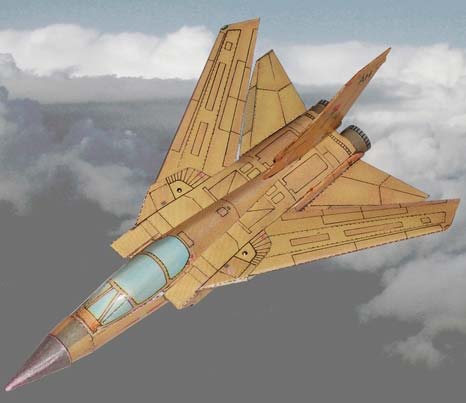 |
Several years ago Chip experimented with postcard models - regular sized models shrunk to about half size and printed on cards 8-1/2 x 6-1/4, with instructions and history and a place for address and stamp crammed on the back. d**n clever idea - I still think it's a flash of genius - but for some reason they never "took off" (excuse the pun) as postcards people would send through the mail. One obvious difficulty with them, besides getting marked and frayed enroute through all the paper mangling machinery of the mails, was that the minute you started to cut out the pieces, so went the instructions into unreadable bits! Anyway, I got boxes of the old postcard models when I bought PMI and I think there might be some life in the things, if promoted properly. One model I have stacks of postcards of is the Panavia Tornado, which has the unique feature of having real swing wings. So I built one, to see if the wings work at postcard scale (they do)! Wingspan wings extended is a diminutive 5-1/2"; the span shrinks to 3-3/8" with the wings tucked back for supersonic flight. These are photos I made up for the PMI website and catalogue, but the model itself is unretouched. Not bad for extra thick cardboard and dime sized pieces! |
|
 |
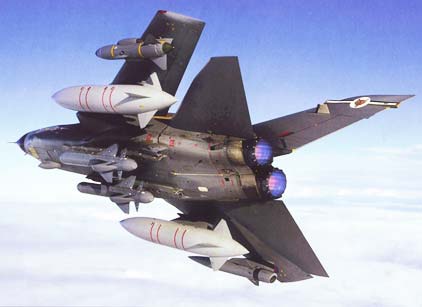 |
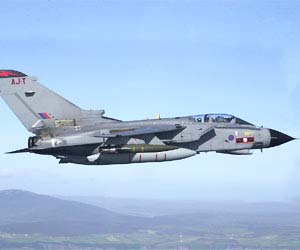 |
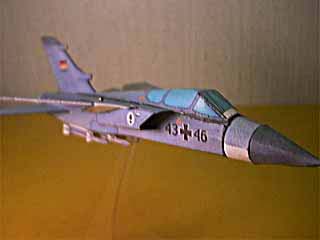 |
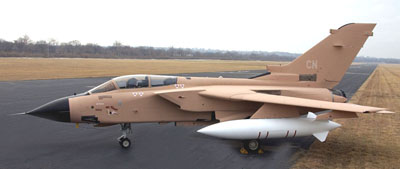
Specifications for the Panavia Tornado
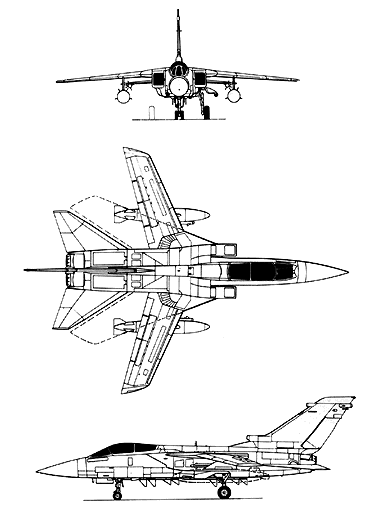 |
Crew: 2 Performance |
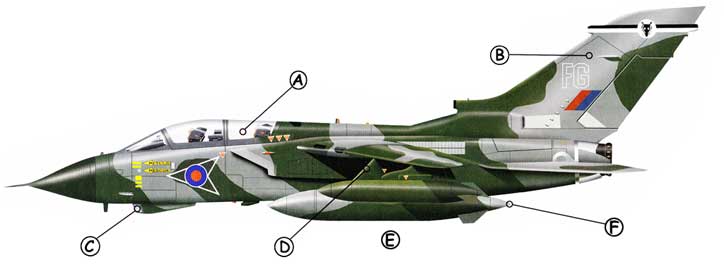 |
||
| A: Matched against the latest military aircraft, the cockpit of the Tornado was becoming dated, so a number of improvements were implemented. | B: Unique to British Tornados is the fuel tank in the fin of the aircraft. which means the Tornado can strike targets at great distances. | C: A distinguishing feature of the GR.Mk 4 IS an extra under-nose fairing housing a GEC TICM II forward looking infra-red unit. |
| D: AIM-9L Sidewinder missiles can be carried on the inner wing pylons. Along with the two 27 mm cannon in the nose, this offers a limited self-defence capability. | E: Dedicated Sea Eagle pylons are positioned on the underside of the fuselage. Control of the missiles is facilitated by an extra panel in the rear cockpit. | F: Plans have been outlined for at least some GR.Mk 1 Bs to be modified to carry the Flight Refueling Mk 20B HDU pods that were previously used by the Victor fleet. |
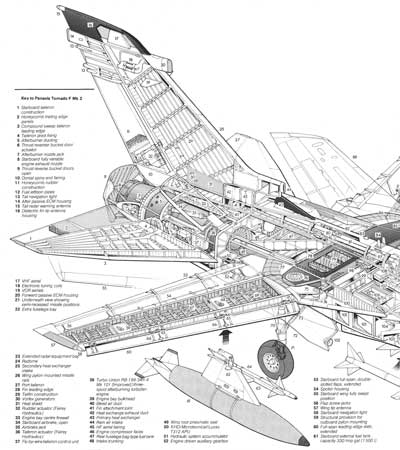 |
|
This fabulous Tornado cutaways comes in a 2MB PDF for FREE included in your MyModels folder! |
|
Instructional Video from Neil Paper Models
This video is a great beginner's guide with some cool tricks for more advanced modelers. Thanks to Neil for all his work making these videos.
